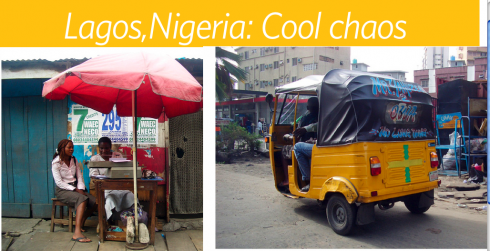
All services available in the streets of Lagos: get your document typed; or take a taxi to go across town
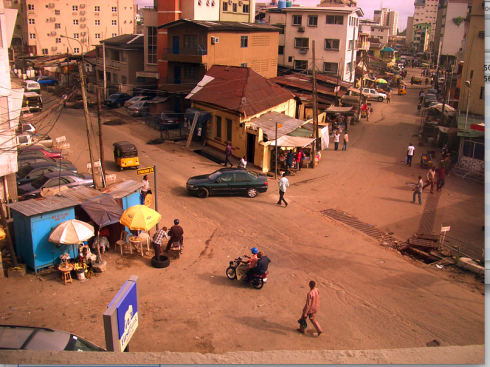
Ron Reason contributes this photo, taken from the window of NEXT’s office. Ron writes: I like the building right in the middle that was chopped in half to make way for the one to the left!

Bananas is her business, and everyone else’s
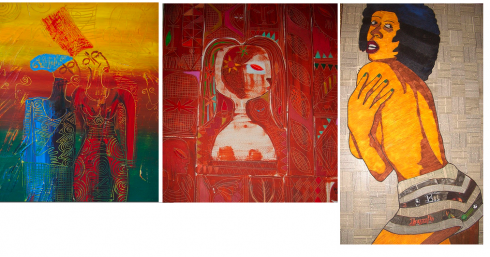
Art abounds in Lagos: what exploits of color on those canvases.
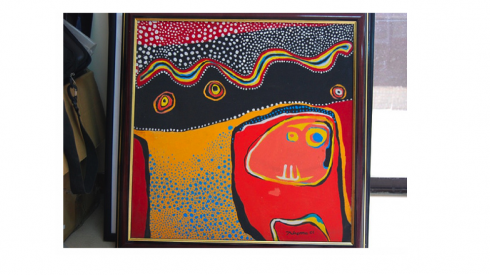
One special artist is Victor Ehiklamenor, whom we discovered in our first trip, and started collecting his work. He is creative director of Next newspaper
(All Lagos photos from the Ron Reason collection, www.ronreason.com)
For more of Ron’s photos of Lagos, go here
http://www.flickr.com/photos/withinreason/sets/72157613909781563/
Best and worst cities: it is all about the memories, isn’t it?
Ok, first the list in order of how truly bad they are: Lagos, Jakarta, Riyadhand Almaty, New Delhi, Mumbai and Chennai. Ouch, three Indian cities on the list. That hurts. Yes, I know them all, and, well, I have to think about my experiences there. The survey was carried out by US business magazine Business Week and New York based Human Resources consultancy ORC.
At the end of the day, it is one’s experiences that contribute to give individuals their impression of a city.
Try the egozy soup to ease the chaos of Lagos
In Lagos, we have most recently worked with the new and colorful daily there, Next. Yes, Lagos is chaotic, a frenetic tempo of cars everywhere, motorcycles that pass so close to you that you rub against them sometimes, then the assorted “mall” in the street concept. All forms of business are transacted directly on the side of the road; you can get a haircut, buy a headstone for your relative’s grave, a gate to protect the entrance to your house, loaves of bread, tires for the car, shampoos and facial creams, and live chickens. It is all there in the longest shopping mall anyone can imagine, extending from the airport to every other part of the city. Call it one stop shopping. Color is a key ingredient: women wear bright colored dresses and turbans. The mangoes are delicious, and so are the papayas. A couple of restaurants offer spectacular local and African fare, and if you get invited to dinner by one of your Lagos friends, chances are that the hospitality will be memorable, not to mention the jazz pianist performing for the occasion. As a runner, a drawback for me is that one cannot dare go run in the streets, not for fear of being attacked, but because it is simply impossible to take more than two steps before running into masses of people, cars, bicycles and motorcycles—-plus the occasional stray dog (never looking too clean or friendly). In Lagos, one runs in the comfort and safety of the fitness club.
The galleries, however, hold some of the most special art one can find anywhere. If there is one element of Lagos that mesmerized me it was the wonderful and colorful art that I found everywhere, from the lobbies of hotels, to restaurants, to, of course, designated galleries. These Nigerian artists are inspired, and their canvases tell us much more than the report about how bad their city is. Here, we find that Lagos is all about imagery, the faces of its people, the color and the rhythm of a vibrant city.
Restaurant tip: Reeds in Ikoyi on Awolowo road. A Thai/Asian fusion kind of place. Great food and ambience. The mojitos are special, and the service, by Lagos standards, fast and courteous.
The day a baby monkey fell on me in Delhi
About the Indian cities: New Delhi, the capital, has plenty of charm, and I am still wondering why this city made the list. We are there often to work with the Hindustantimes, a project that is work in progress at the moment. True, this city is home to about 11 million residents, and I think I have met them all at lunchtime in the streets. I love the architecture of New Delhi, its embassy row, not to mention the Minar, the world’s tallest free standing minaret, along with the Humayun’s Tomb, a must see. However, when my driver takes me past the India Gate, at night, one realizes how marvelous this place can be. As for where to go: if you are in the mood for a real tea experience, colonial style, try The Atrium, a tea room at the 1930’s Imperial Hotel. Sit by the fountain in this Raj-era environment, and, of course, indulge into the highly caloric world of very sweet cakes and pastries. The green tea is special, add the honey from Kerala. Yes, I did ventured out to run by Embassy Row in one of my early trips to Delhi. Surprise! A baby monkey fell out of a tree and unto my shoulders, got tangled up with my iPod. I returned to the hotel, never to run out in the streets of New Delhi again. And, no, there is no YouTube video of the experience.
Buy that coconut in the streets of Mumbai!
In Mumbai (formerly Bombay), we worked with Midday, that loud but happy street tabloid that sings headlines as in a sort of Bollywood flick just about lunchtime everyday. The trip to and from the airport are reminders of the poverty and the slums now made very famous by the Oscar-winning film, Slumdog Millionaire. Of course, Mumbai is the entertainment capital, and if you are lucky, you may run into some famous Bollywood star, such as Aishwarya Rai-Bachchanm (Ash) the most bankable star from Bollywood in Hollywood, or the newcomer Frieda Pinto, of Slumdog fame. The stars have their mansions in Mumbai, a la Beverly Hills, although I never visited one. One interesting tip: stop and get a coconut from a street vendor. These are succulent coconuts, with delicious white meat inside, and semisweet water (good for your kidneys). Memorable restaurant: India Jones, at the Hilton Towers. What to eat there? Good luck, choices will be tough here. Start with the superb array of chicken/prawn spring roll, satay chicken, and raw papaya salad with lime, mint, and basil, served with a selection of dips. But my favorite is the “India Jones Grand Platter”: an appetizer assortment; soup (tom kha or chicken and coriander); and a platter of green chicken curry, stir-fried sea bass with celery, barbecued pork with honey, wok-fried mixed vegetables in black-peppercorn sauce . Everything here is good. No running in the streets of Mumbai either! Stay indoors for your running, but step out to get that coconut from the street vendors.
What did the little bird say is in the cards for you?
In Chennai we did The Hindu, among other publications of the same house. I remember the beach, where one can go for a run, or simply sit and contemplate the serenity of the sea on one side, and the chaos of the traffic a few feet away. Two worlds collide here. Chennai is India’s fourth largest city and it is booming, although it does not have the charms of New Delhi or Bombai. Established on the site of a fishing village in 1639 as the first British settlement in India, the capital of Tamil Nadu (formerly Madras) is more of a sprawling, bustling industrial metropolis, a manufacturing hub known as the “Detroit of the South,” where 9 of the top 10 Indian IT companies are located. Of particular interest to me Chennai University, with its buildings reminiscent of British campuses. Where to eat: my favorite spot for dinner is Raintree, at the Taj Connemara Hotel. Lucky me, my hosts here have been Mr. and Mrs. Ram, and Marian Ram is not only a great chef herself, but she knows what to order for her guests when we come to Raintree or any other restaurant: After sipping a welcome drink of honey-sweetened tender coconut water, delicately flavored with mint leaves—you must try the chicken marinated in a curry leaf paste and deep fried, as a starter, along with pickle-filled cocktail idlies and Kuzhi paniaram (rice and lentil batter tempered with spices and shallow fried on a special griddle). For a main course, if you have space, try the kozhi Chettinad, deliciously tender boneless chicken in an authentic Chettinad gravy. For dessert, no question about it: try the fresh mango.
And, by the way, while you wait, you can have the blind card reader tell you about your future. He sits on the floor, a small green bird near him, picking out the cards that the man will read for you.
A translator is at hand.
As you can see, I have all wonderful memories of working and interacting in these so called “worst cities.”
Cities and memories: the Havana of my childhood, sweet, vibrant and musical
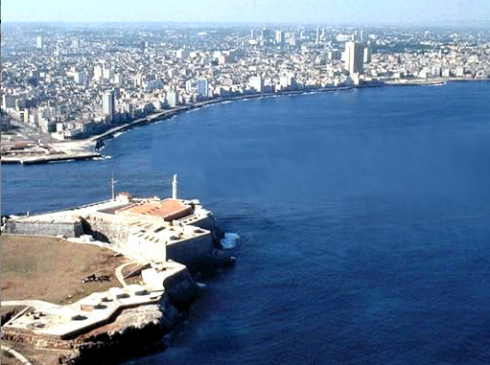
I remember growing up in this Havana of the 1950s
My friend Ron Reason and I were discussing cities yesterday, since he has travelled with me to some of these locations as well. I could not help but remember the city of my childhood, Havana, Cuba.
I sort of romanticized Havana, because my recollection of it is that of a child who happened to be a television/theater actor, always moving around the best side of that city. My father played saxophone at the lusciously tropical Tropicana night club,and he would take me there often, as well as to El Floridita where Hemingway had his favorite mojitos(I would drink a Coke) or to eat fried rice at La Plaza del Vapor, Cuban’s version of Chinatown, truly a steaming and crowded mass of humanity on the go. And how can I forget walking at night by El Paseo del Prado and seeing one of the world’s only ALL WOMEN orchestras, with Las Mulatas del Fuego. With my father, it was always the city and its music. That is how I remember it.
So, perhaps a westerner’s view of Havana of the 1950s would have been: chaotic, very Latin in a disorganized sort of way. To me Havana was heaven, honey, champagne and music mixed together. I treasure those memories of my city. I know it has changed, but I have not seen it since 1962. Do I wish to return and see it again before I die? Of course. Top of my wish list.
Ask residents of Lagos, New Delhi, Mumbai or Chennai about their respective cities, and I am sure they will tell you: ignore those ratings, we live here, we have the memories, we know where the good things are, and it isn’t so bad.
I tend to agree, since I always go by that wise saying: Nothing is ever as good or as bad as it seems (or as the latest surveys make it out to be).
For BusinessWeek article/video:
http://images.businessweek.com/ss/09/03/0304_difficult_cities/index.htm
My favorite FIVE cities
While on the subject of lists, here are my five fovorites, a list that has not changed in many years:
New York City, Paris, Stockholm, Buenos Aires and Cape Town
John Duncan in Garcia Interactive blog
Duncan writes that 85 percent of newspapers will be dead by 2011.
It pains me to say this because it wasn’t inevitable as recently as two years ago. But it is now. The math and the market pretty much guarantee it.
For complete blog posting:
http://garciainteractive.com/blog/view/35/
:
To read TheRodrigoFino blog, in Spanish, go:
https://garciamedia.com/latinamerica/blog/
TheMarioBlog posting #212